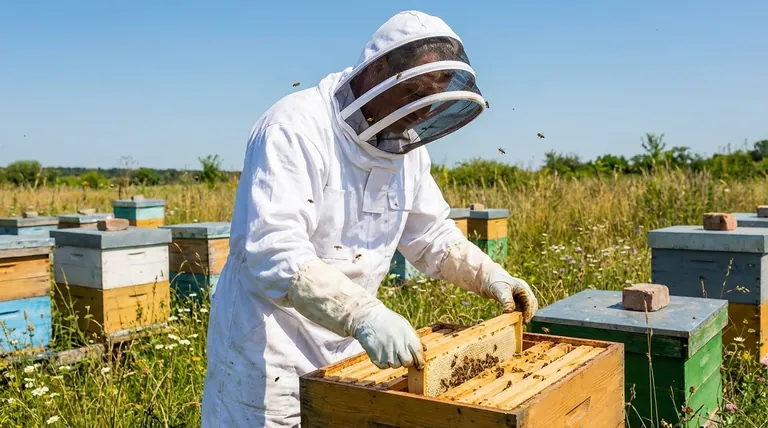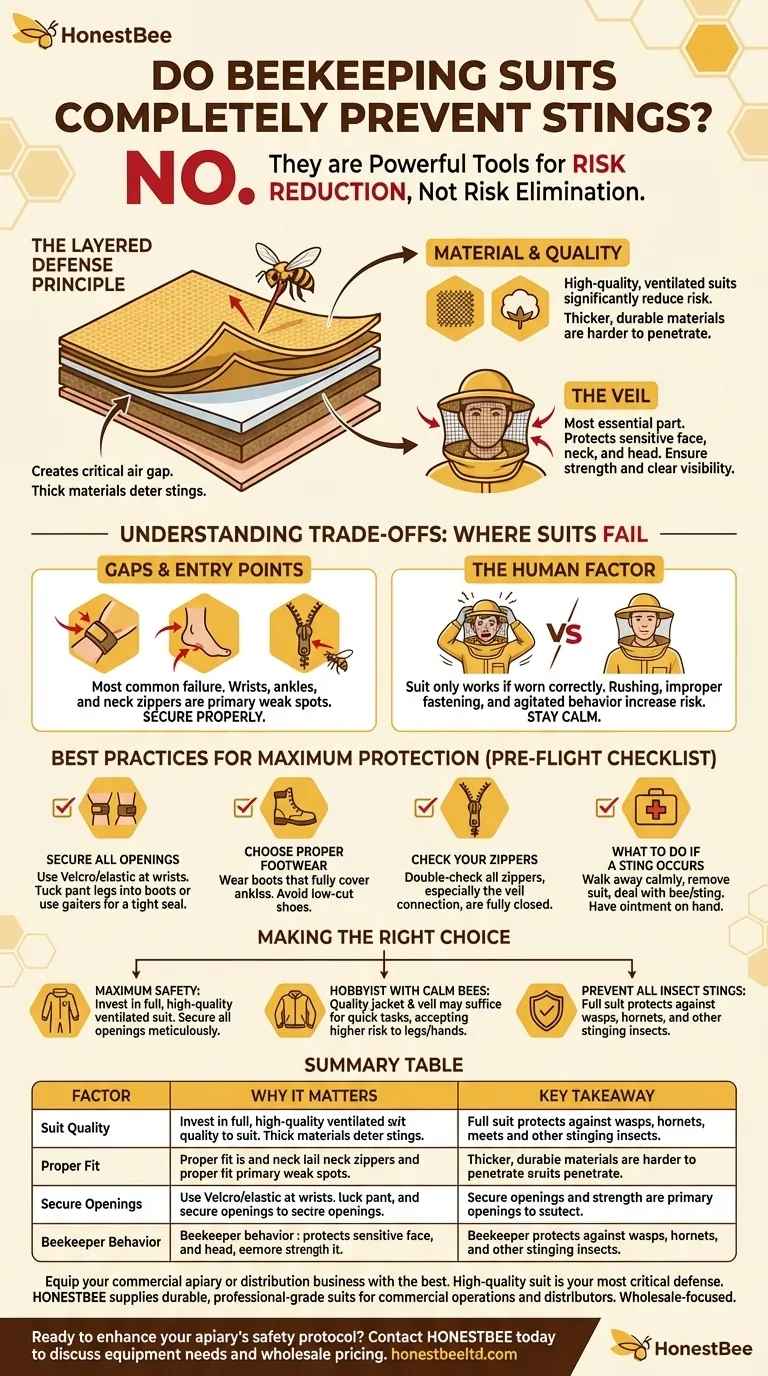To be direct, no. A beekeeping suit does not make you completely sting-proof. While a high-quality suit is the single most effective piece of protective equipment you can wear, it functions as a powerful tool for risk reduction, not risk elimination. A determined bee can still potentially sting through the material or, more commonly, find its way inside through a gap.
Your beekeeping suit is a critical layer of defense, but its effectiveness depends heavily on three factors: the quality of the suit, how you wear it, and your own behavior around the bees. True safety comes from understanding how all three work together.

How a Bee Suit Reduces Risk
A beekeeping suit is designed on the principle of defense in depth. It doesn't just block a bee's stinger; it creates a comprehensive system to deter and prevent stings.
The Principle of Layered Defense
The most important feature of a bee suit is the space it creates between the fabric and your skin. Bees' stingers are relatively short, so thick or layered fabric prevents the stinger from ever reaching you.
This is why a loose-fitting suit is more protective than a tight one. It maximizes that critical air gap.
Why Material and Quality Matter
A high-quality bee suit significantly reduces the chance of being stung compared to simple coveralls. Better suits use thicker, more durable materials that are harder for a bee's stinger to penetrate.
Ventilated suits, which use multiple layers of mesh, are particularly effective. They offer excellent protection while keeping you cool, which in turn helps you stay calm.
The Critical Role of the Veil
The veil is arguably the most essential part of the suit. It protects your face, neck, and head—the most sensitive and dangerous areas to be stung.
A good veil provides strength and clear visibility, ensuring you can work confidently and safely without compromising your protection.
Understanding the Trade-offs: Where Suits Can Fail
Trusting your suit is important, but understanding its limitations is what truly keeps you safe. Stings that occur while wearing a suit almost always happen for a few predictable reasons.
Gaps at Entry Points
The most common failure point is not the fabric itself, but the openings. Bees are experts at finding small gaps.
Wrists, ankles, and the neck zipper are the primary weak spots. If these areas are not properly secured, a bee can easily crawl inside your suit.
The Human Factor: Improper Use
A suit is only as good as how you wear it. Rushing to put it on, failing to zip it up completely, or leaving a wrist cuff unfastened are common mistakes.
Likewise, agitated behavior can provoke a more persistent defensive response from the bees, increasing the likelihood they will find a weak point in your gear. Staying calm and deliberate is a form of protection itself.
Best Practices for Maximum Protection
You can dramatically increase your suit's effectiveness by adopting a few simple habits. Think of it as a pre-flight checklist before entering the apiary.
Secure All Openings
This is the most important step. Use the built-in Velcro or elastic at the wrists. For ankles, tuck your pant legs into your boots or use string, rubber bands, or ankle gaiters to create a tight seal.
Choose Proper Footwear
Wear boots that fully cover your ankle and allow the suit's pant legs to be securely tucked in or pulled over. Avoid low-cut shoes that can easily expose your ankles if the suit rides up.
Check Your Zippers
Before you approach a hive, double-check that all zippers, especially the one connecting your veil to the suit, are fully and securely closed. A small gap here is a direct invitation for a bee.
What to Do If a Sting Occurs
Even with all precautions, a sting can happen. If a bee gets inside your suit, walk calmly away from the hive, remove the suit, and then deal with the bee and the sting. Having an ointment on hand can help alleviate the immediate pain.
Making the Right Choice for Your Goal
Ultimately, a bee suit is a tool, and you must use it correctly to achieve your safety goal.
- If your primary focus is maximum safety: Invest in a full, high-quality, ventilated suit and meticulously secure every opening at the wrists, ankles, and neck before every inspection.
- If you are a hobbyist with calm bees: A quality jacket and veil may be sufficient for quick tasks, but you must consciously accept the higher risk of stings to your legs and hands.
- If your goal is to prevent stings from any insect: A full bee suit offers excellent protection not just from honey bees, but also from wasps, hornets, and other stinging insects.
By understanding its function and its limitations, your bee suit becomes your most reliable partner in the apiary.
Summary Table:
| Factor | Why It Matters | Key Takeaway |
|---|---|---|
| Suit Quality | Determines material thickness and durability. | High-quality, ventilated suits offer superior sting resistance. |
| Proper Fit | Creates a critical air gap between fabric and skin. | A loose-fitting suit is more protective than a tight one. |
| Secure Openings | Prevents bees from entering through gaps. | Always seal wrists, ankles, and the neck zipper completely. |
| Beekeeper Behavior | Calm movements reduce bee agitation. | Your demeanor is a form of protection; stay deliberate and calm. |
Equip your commercial apiary or distribution business with the best. A high-quality beekeeping suit is your most critical layer of defense, but its effectiveness depends on the gear's quality and proper use. HONESTBEE supplies durable, professional-grade beekeeping suits and equipment designed for the demands of commercial operations and distributors. Our wholesale-focused model ensures you get reliable protection that maximizes safety and productivity.
Ready to enhance your apiary's safety protocol? Contact HONESTBEE today to discuss your equipment needs and wholesale pricing.
Visual Guide

Related Products
- Cotton Beekeeping Suit and Round Hat with Veil Bee Keeper Protective Gear
- Professional Beekeeping Suit for Kids and Girls Childrens Bee Keeper Suit
- White Beekeeping Protective Suit and Hat with Fencing Veil for Beekeepers
- Beekeeper Cowboy Hat and Veil for Beekeeping
- Heavy Duty Cowboy Beekeeper Hat with Visibility Veil Outdoor Professional Beekeeping Protective Gear
People Also Ask
- What factors should be considered when choosing a beekeeping suit? Balance Safety, Comfort & Performance
- What is recommended for beginners in beekeeping regarding protective clothing? A Complete Safety Guide for New Beekeepers
- How should a bee suit be cleaned? Protect Your Investment and Ensure Apiary Safety
- Why is a jacket with a hat veil recommended for beekeepers? Essential Protection for Your Face and Neck
- How should a beekeeping suit be hung to maintain its shape? Protect Your Investment with Proper Storage



















